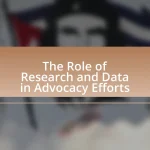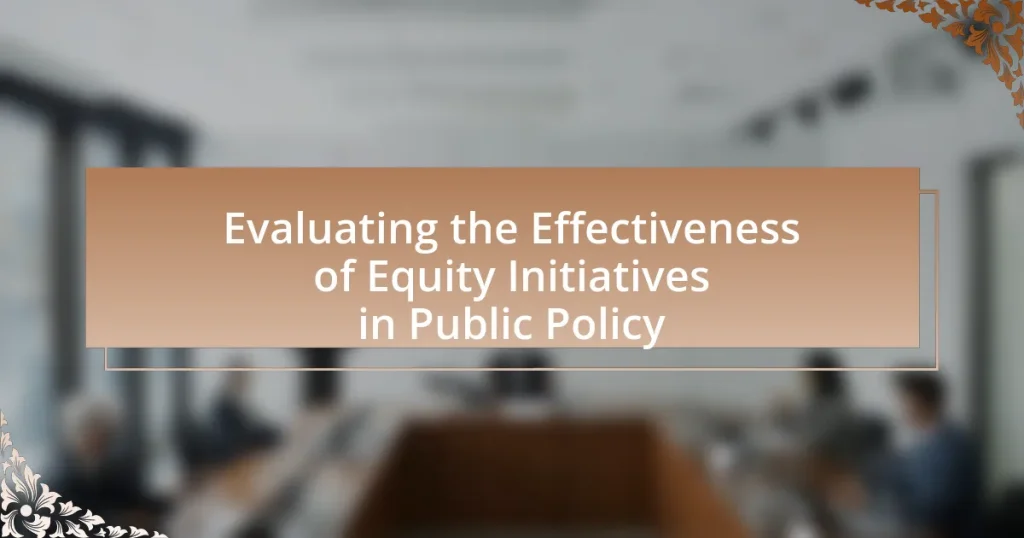The article focuses on evaluating the effectiveness of equity initiatives in public policy, which are designed to promote fairness and justice in resource distribution among social groups. It outlines how these initiatives address systemic inequalities through targeted policies in areas such as education, healthcare, and employment. Key components of effective equity initiatives include clear objectives, stakeholder engagement, data-driven decision-making, and continuous evaluation. The article also discusses the differences between equity initiatives and traditional policy approaches, the importance of evaluation, and the challenges faced in measuring effectiveness, including systemic biases and the need for inclusive methodologies. Additionally, it highlights best practices for enhancing evaluations, such as utilizing mixed-methods approaches and establishing continuous feedback loops.
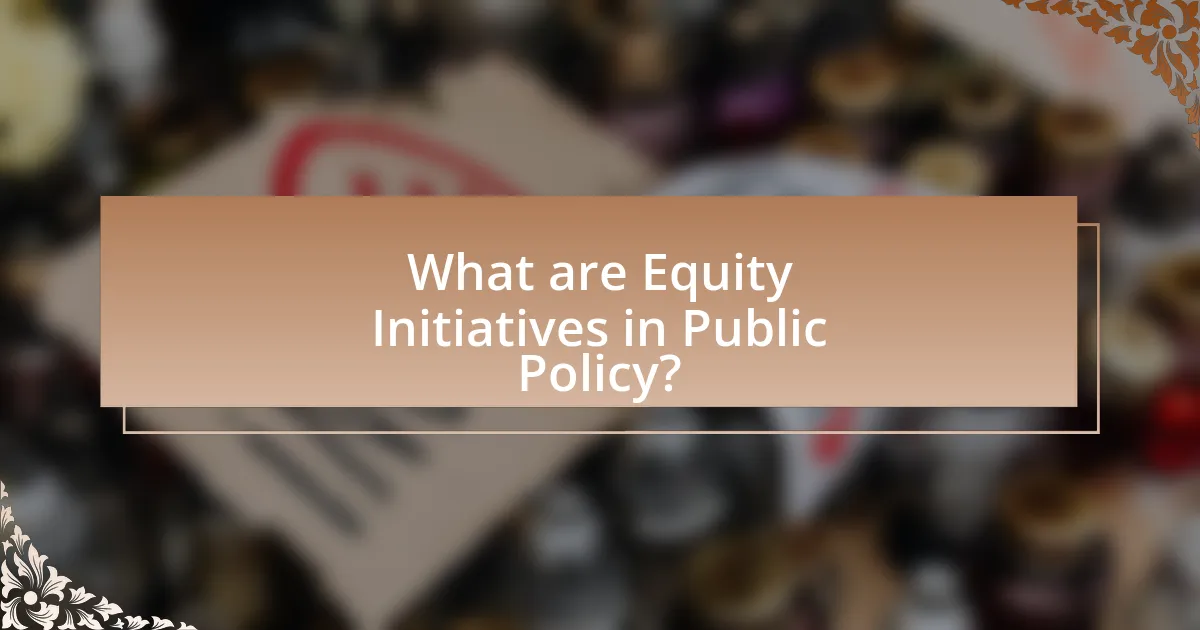
What are Equity Initiatives in Public Policy?
Equity initiatives in public policy are strategies designed to promote fairness and justice in the distribution of resources and opportunities among different social groups. These initiatives aim to address systemic inequalities by implementing policies that specifically target marginalized communities, ensuring that all individuals have access to essential services such as education, healthcare, and employment. For instance, the U.S. Department of Education’s Equity Assistance Centers provide support to school districts in creating equitable educational environments, demonstrating a concrete application of equity initiatives in public policy.
How do Equity Initiatives aim to address social disparities?
Equity initiatives aim to address social disparities by implementing targeted policies and programs that promote equal access to resources and opportunities for marginalized communities. These initiatives often focus on areas such as education, healthcare, and employment, ensuring that disadvantaged groups receive the necessary support to overcome systemic barriers. For example, research from the National Equity Atlas indicates that equitable investments in education can significantly improve outcomes for low-income students and students of color, thereby reducing achievement gaps. By prioritizing equity in public policy, these initiatives seek to create a more just society where all individuals can thrive regardless of their background.
What are the key components of effective Equity Initiatives?
The key components of effective Equity Initiatives include clear objectives, stakeholder engagement, data-driven decision-making, and continuous evaluation. Clear objectives define the specific goals of the initiative, ensuring that efforts are focused and measurable. Stakeholder engagement involves actively involving affected communities in the planning and implementation processes, which fosters trust and relevance. Data-driven decision-making relies on accurate data to identify disparities and measure progress, allowing for informed adjustments to strategies. Continuous evaluation ensures that initiatives are assessed regularly for effectiveness, enabling timely modifications based on outcomes and feedback. These components collectively enhance the impact and sustainability of equity initiatives in public policy.
How do Equity Initiatives differ from traditional policy approaches?
Equity initiatives differ from traditional policy approaches by prioritizing fairness and addressing systemic inequalities rather than applying uniform solutions to all. Traditional policies often focus on broad, one-size-fits-all strategies that may overlook the unique challenges faced by marginalized groups. In contrast, equity initiatives specifically target disparities in access, resources, and opportunities, aiming to create tailored solutions that consider the historical and social contexts of disadvantaged populations. For example, research by the Urban Institute highlights that equity-focused policies can lead to improved outcomes in education and health by addressing the root causes of inequality, demonstrating their effectiveness in fostering inclusive growth.
Why is evaluating the effectiveness of Equity Initiatives important?
Evaluating the effectiveness of Equity Initiatives is important because it ensures that resources are allocated efficiently and that the intended outcomes of promoting fairness and inclusion are achieved. By assessing these initiatives, policymakers can identify successful strategies and areas needing improvement, thereby enhancing the overall impact on marginalized communities. For instance, a study by the Urban Institute found that effective evaluation can lead to a 20% increase in the success rate of equity programs by allowing for data-driven adjustments and targeted interventions. This evidence underscores the necessity of evaluation in fostering equitable public policy.
What metrics are commonly used to assess effectiveness?
Common metrics used to assess effectiveness in evaluating equity initiatives in public policy include outcome measures, process measures, and impact assessments. Outcome measures evaluate the direct results of initiatives, such as changes in income levels or access to services among targeted populations. Process measures assess the implementation of initiatives, focusing on fidelity to the program design and engagement levels of participants. Impact assessments analyze the broader effects of initiatives on community well-being and social equity, often utilizing statistical methods to determine causal relationships. These metrics provide a comprehensive framework for understanding the effectiveness of equity initiatives.
How can stakeholder feedback influence evaluation outcomes?
Stakeholder feedback can significantly influence evaluation outcomes by providing insights that shape the assessment criteria and methodologies used. When stakeholders, such as community members or policy implementers, share their perspectives, they can highlight relevant issues, needs, and priorities that may not have been initially considered. For instance, a study by the Urban Institute found that incorporating stakeholder input led to more relevant evaluation metrics, which improved the overall effectiveness of equity initiatives in public policy. This feedback loop ensures that evaluations are not only reflective of the intended goals but also resonate with the actual experiences and expectations of those affected by the policies.
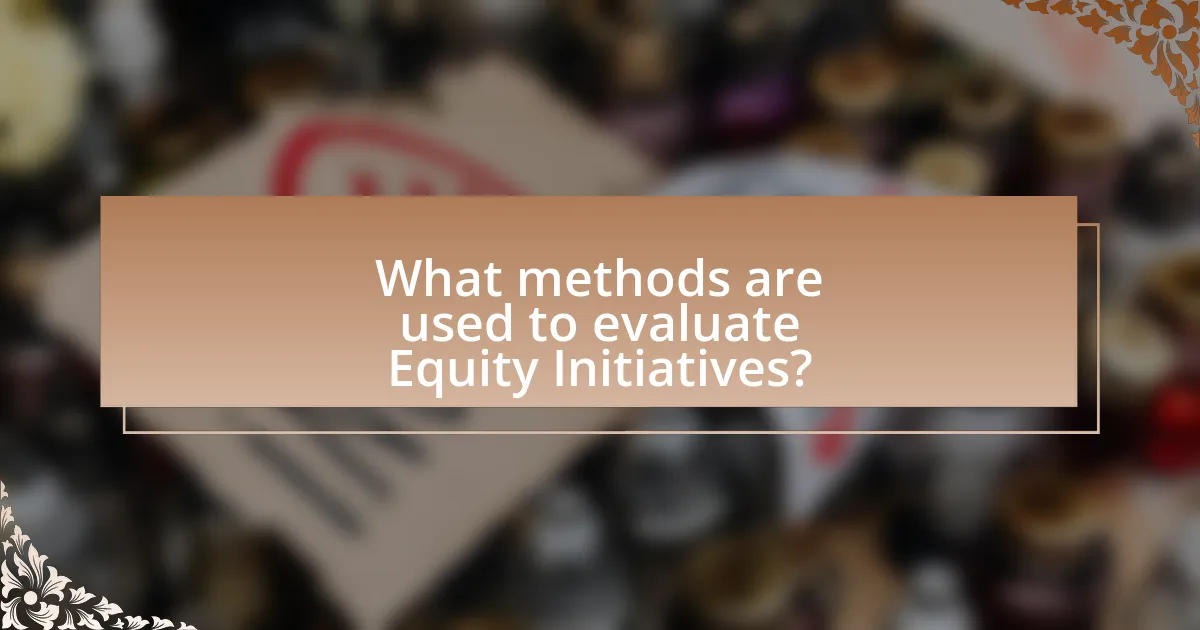
What methods are used to evaluate Equity Initiatives?
Methods used to evaluate equity initiatives include quantitative analysis, qualitative assessments, and mixed-method approaches. Quantitative analysis often involves statistical techniques to measure outcomes such as access, participation, and impact on various demographic groups, utilizing data from surveys or administrative records. Qualitative assessments gather insights through interviews, focus groups, or case studies to understand the experiences and perceptions of affected communities. Mixed-method approaches combine both quantitative and qualitative data to provide a comprehensive evaluation, allowing for a deeper understanding of the initiative’s effectiveness. These methods are validated by their widespread application in studies assessing social programs, demonstrating their ability to capture both numerical data and personal narratives, which are essential for a holistic evaluation of equity initiatives.
How do qualitative and quantitative methods differ in evaluation?
Qualitative and quantitative methods differ in evaluation primarily in their approach to data collection and analysis. Qualitative methods focus on understanding the underlying reasons, motivations, and experiences of individuals through interviews, focus groups, and open-ended surveys, allowing for in-depth insights into complex issues. In contrast, quantitative methods emphasize numerical data and statistical analysis, utilizing structured surveys and experiments to measure variables and identify patterns, which can be generalized across larger populations. For instance, a study evaluating public policy initiatives might use qualitative interviews to explore community perceptions while employing quantitative surveys to assess the overall impact on service access. This distinction highlights how qualitative methods provide context and depth, whereas quantitative methods offer breadth and generalizability in evaluating effectiveness.
What are the advantages of using mixed-methods approaches?
Mixed-methods approaches offer several advantages in evaluating the effectiveness of equity initiatives in public policy. Firstly, they combine qualitative and quantitative data, providing a comprehensive understanding of complex issues. This integration allows researchers to validate findings through triangulation, enhancing the credibility of the results. For instance, qualitative interviews can reveal the lived experiences of individuals affected by policies, while quantitative surveys can measure the extent of these impacts across a larger population. Additionally, mixed-methods approaches facilitate the exploration of different dimensions of equity, such as access, outcomes, and perceptions, leading to more nuanced insights. This methodological diversity ultimately supports more informed decision-making and policy development.
How can case studies enhance understanding of initiative effectiveness?
Case studies enhance understanding of initiative effectiveness by providing detailed, contextual insights into real-world applications and outcomes of specific initiatives. They allow researchers and policymakers to analyze the complexities of implementation, including challenges faced and strategies employed, which quantitative data alone may not capture. For instance, a case study on a successful equity initiative in a public policy context can reveal how stakeholder engagement and community feedback influenced its effectiveness, thereby offering valuable lessons for future initiatives. This qualitative evidence supports a deeper comprehension of the factors that contribute to or hinder success, making case studies a critical tool in evaluating initiative effectiveness.
What role does data play in evaluating Equity Initiatives?
Data is essential in evaluating Equity Initiatives as it provides measurable evidence of their impact and effectiveness. By collecting and analyzing quantitative and qualitative data, policymakers can assess disparities in access, outcomes, and participation among different demographic groups. For instance, data on income levels, educational attainment, and health outcomes can reveal whether equity initiatives are successfully addressing systemic inequalities. Furthermore, studies such as the “Equity in Public Policy: A Data-Driven Approach” by the Urban Institute demonstrate that data-driven evaluations lead to informed decision-making and resource allocation, ultimately enhancing the effectiveness of equity initiatives.
How can data collection methods impact evaluation results?
Data collection methods significantly impact evaluation results by influencing the quality, reliability, and validity of the data gathered. For instance, quantitative methods like surveys can yield statistically significant results, but may overlook nuanced qualitative insights that qualitative methods, such as interviews or focus groups, can capture. A study by the American Evaluation Association highlights that mixed-method approaches often provide a more comprehensive understanding of program effectiveness, as they combine the strengths of both quantitative and qualitative data. Therefore, the choice of data collection method directly affects the conclusions drawn from evaluations, shaping policy decisions and resource allocation in equity initiatives.
What types of data are most relevant for assessing equity outcomes?
Quantitative data, qualitative data, and demographic data are most relevant for assessing equity outcomes. Quantitative data includes metrics such as income levels, employment rates, and educational attainment, which provide measurable insights into disparities. Qualitative data, gathered through interviews and focus groups, offers context and personal experiences that illuminate the lived realities of affected populations. Demographic data, encompassing race, ethnicity, gender, and geographic location, is essential for identifying specific groups that may experience inequities. Together, these data types enable a comprehensive analysis of equity outcomes, allowing policymakers to identify gaps and tailor interventions effectively.
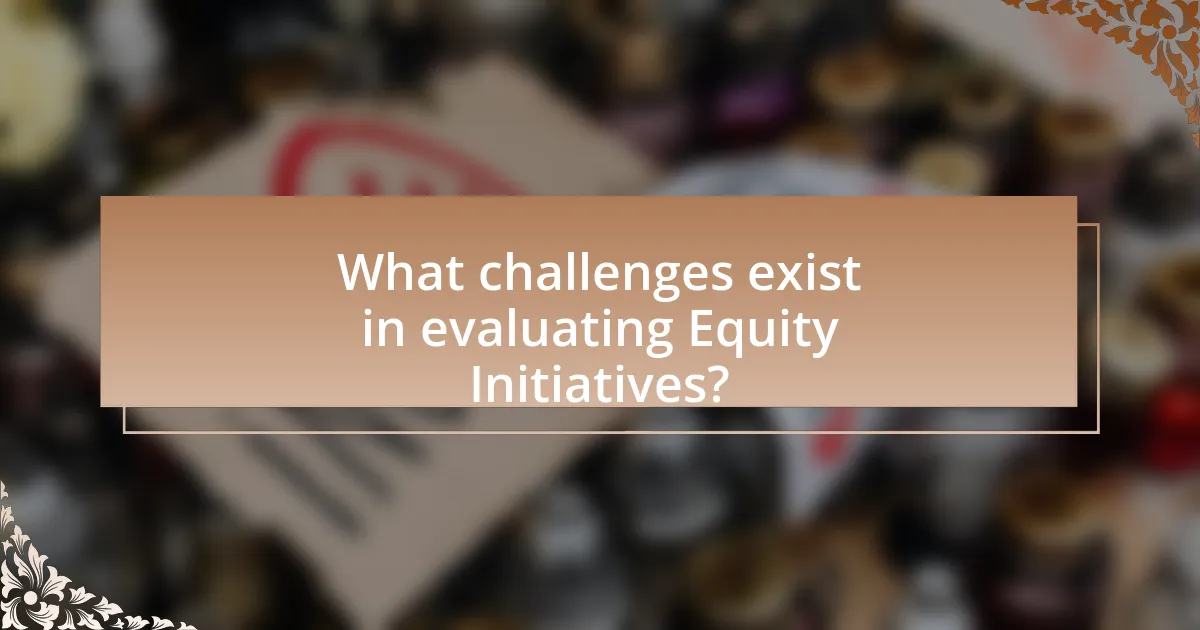
What challenges exist in evaluating Equity Initiatives?
Evaluating equity initiatives presents several challenges, primarily due to the complexity of measuring outcomes and the diversity of stakeholder perspectives. One significant challenge is the difficulty in establishing clear metrics for success, as equity initiatives often aim to address multifaceted social issues that do not lend themselves to straightforward quantitative analysis. Additionally, data availability and quality can hinder evaluation efforts; many equity initiatives target marginalized communities, where data may be sparse or unreliable. Furthermore, the subjective nature of equity can lead to differing interpretations of what constitutes success among stakeholders, complicating consensus on evaluation criteria. These challenges are supported by research indicating that effective evaluation requires not only robust data but also an understanding of the social context in which initiatives operate, as highlighted in the report “Measuring Equity: A Guide for Evaluators” by the American Evaluation Association.
How do systemic biases affect evaluation processes?
Systemic biases significantly distort evaluation processes by introducing inequities that affect the assessment of programs and policies. These biases can manifest in various forms, such as racial, gender, or socioeconomic prejudices, leading to skewed data collection, interpretation, and decision-making. For instance, research indicates that evaluations often prioritize metrics that reflect dominant cultural values, which can marginalize the experiences and needs of underrepresented groups. A study by the National Academy of Sciences found that biased evaluation frameworks can result in misallocation of resources, ultimately undermining the effectiveness of equity initiatives in public policy.
What strategies can mitigate bias in evaluations?
To mitigate bias in evaluations, implementing standardized evaluation criteria is essential. Standardized criteria ensure that all evaluations are conducted using the same benchmarks, reducing subjective interpretations that can lead to bias. Research indicates that using rubrics can enhance objectivity; for instance, a study by the American Educational Research Association found that structured rubrics significantly decreased evaluator bias in educational assessments. Additionally, incorporating diverse evaluation teams can provide multiple perspectives, further minimizing individual biases. A report from the National Academy of Sciences highlights that diverse teams are more effective in identifying and addressing biases in evaluations.
How can evaluators ensure inclusivity in their assessments?
Evaluators can ensure inclusivity in their assessments by employing diverse evaluation teams and utilizing culturally responsive methodologies. Diverse teams bring varied perspectives that help identify and mitigate biases, ensuring that assessments reflect the experiences of all stakeholders. Culturally responsive methodologies, such as participatory evaluation, actively involve marginalized communities in the evaluation process, allowing their voices to shape the assessment criteria and outcomes. Research indicates that inclusive evaluation practices lead to more accurate and relevant findings, as they account for the unique contexts and needs of different populations.
What are common pitfalls in evaluating Equity Initiatives?
Common pitfalls in evaluating equity initiatives include a lack of clear metrics, insufficient stakeholder engagement, and failure to account for systemic barriers. Without clear metrics, it becomes challenging to measure success or progress, leading to ambiguous outcomes. Insufficient stakeholder engagement can result in initiatives that do not address the actual needs of affected communities, undermining their effectiveness. Additionally, failing to account for systemic barriers, such as institutional racism or economic inequality, can skew results and lead to misguided conclusions about the initiative’s impact. These pitfalls can ultimately hinder the ability to assess the true effectiveness of equity initiatives in public policy.
How can over-reliance on quantitative data skew results?
Over-reliance on quantitative data can skew results by leading to an incomplete understanding of complex social issues. Quantitative data often simplifies multifaceted problems into numerical values, which can obscure important qualitative factors such as individual experiences, cultural contexts, and systemic barriers. For instance, a study by the Urban Institute found that focusing solely on numerical metrics in evaluating equity initiatives can overlook the lived realities of marginalized communities, resulting in policies that fail to address their specific needs. This reliance on numbers can create a false sense of accuracy and lead to misguided conclusions, ultimately undermining the effectiveness of public policy aimed at promoting equity.
What are the consequences of ignoring community perspectives?
Ignoring community perspectives leads to ineffective public policies that fail to address the actual needs and concerns of the population. When policymakers overlook the insights and experiences of community members, they risk implementing solutions that are misaligned with local realities, resulting in wasted resources and potential harm. For instance, a study by the Urban Institute found that community engagement in policy development significantly improves program outcomes and increases public trust. Additionally, ignoring these perspectives can exacerbate social inequalities, as marginalized groups may feel further alienated and disenfranchised, leading to increased social unrest and resistance to policy initiatives.
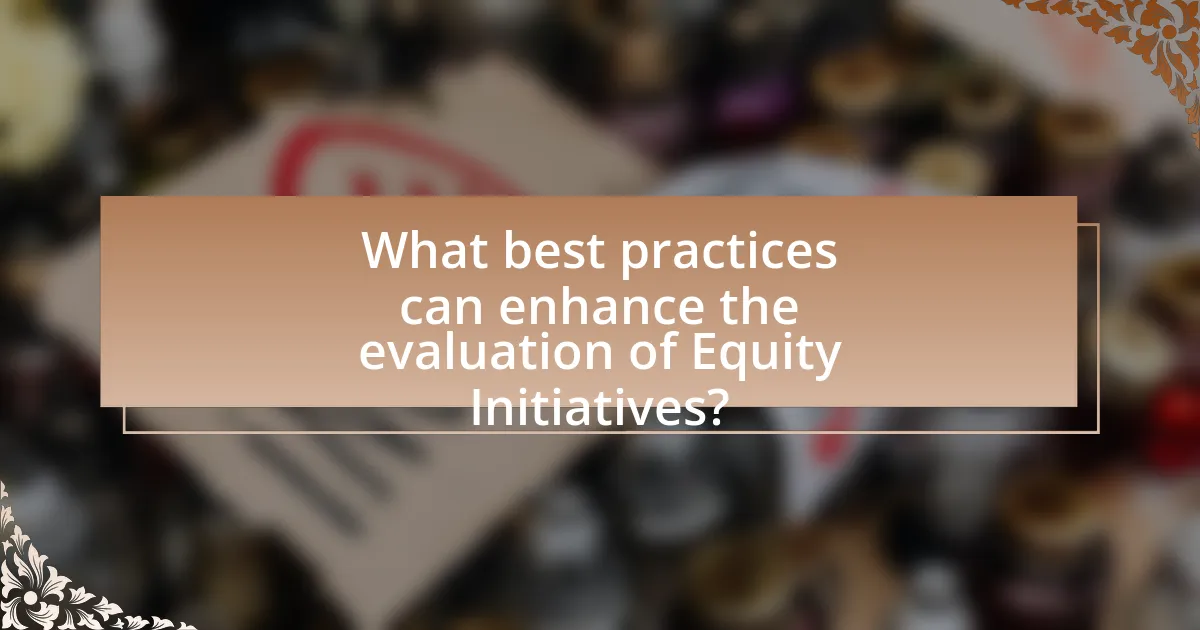
What best practices can enhance the evaluation of Equity Initiatives?
Best practices that can enhance the evaluation of Equity Initiatives include establishing clear, measurable objectives, engaging stakeholders throughout the evaluation process, and utilizing mixed-methods approaches for comprehensive data collection. Clear objectives allow for specific metrics to assess progress, while stakeholder engagement ensures that diverse perspectives inform the evaluation, enhancing relevance and accuracy. Mixed-methods approaches, combining quantitative and qualitative data, provide a fuller picture of the initiative’s impact, as evidenced by studies showing that such methodologies yield richer insights into community needs and outcomes.
How can collaboration with community stakeholders improve evaluations?
Collaboration with community stakeholders can improve evaluations by enhancing the relevance and accuracy of the assessment process. Engaging stakeholders ensures that the evaluation criteria reflect the community’s needs and priorities, leading to more meaningful outcomes. For instance, studies have shown that evaluations incorporating stakeholder input yield insights that are more aligned with real-world contexts, thereby increasing the validity of the findings. Additionally, involving community members fosters trust and transparency, which can lead to higher participation rates and more comprehensive data collection. This collaborative approach has been supported by research indicating that stakeholder engagement in evaluations can lead to more actionable recommendations and improved policy implementation.
What frameworks can guide effective evaluation practices?
The frameworks that can guide effective evaluation practices include the Logic Model, the Theory of Change, and the Utilization-Focused Evaluation. The Logic Model provides a visual representation of the relationship between resources, activities, outputs, and outcomes, facilitating clarity in evaluation design. The Theory of Change outlines the steps necessary to achieve desired outcomes, emphasizing the causal pathways and assumptions involved. Utilization-Focused Evaluation prioritizes the intended use of evaluation findings by engaging stakeholders throughout the process, ensuring that evaluations are relevant and actionable. These frameworks are supported by empirical research, such as the work of Patton (2008) on Utilization-Focused Evaluation, which demonstrates that stakeholder engagement enhances the effectiveness and applicability of evaluation results.
How can continuous feedback loops be established in evaluations?
Continuous feedback loops in evaluations can be established by integrating regular data collection and stakeholder engagement throughout the evaluation process. This approach ensures that feedback is not only gathered at the end of an evaluation but is continuously solicited from participants, stakeholders, and data sources. For instance, utilizing surveys, interviews, and focus groups at multiple stages allows for real-time insights and adjustments to be made, enhancing the relevance and effectiveness of the evaluation. Research indicates that organizations employing iterative feedback mechanisms see improved outcomes, as they can adapt strategies based on ongoing input, thereby fostering a culture of responsiveness and accountability in public policy initiatives.
What practical steps can policymakers take to ensure effective evaluations?
Policymakers can ensure effective evaluations by establishing clear evaluation frameworks that include specific objectives, measurable outcomes, and appropriate methodologies. These frameworks should be designed to assess the impact of equity initiatives systematically, allowing for data collection and analysis that informs decision-making. For instance, the Government Accountability Office (GAO) emphasizes the importance of using performance metrics and stakeholder feedback to refine policies and improve outcomes. Additionally, integrating continuous learning processes into evaluations can help policymakers adapt strategies based on real-time data and findings, thereby enhancing the overall effectiveness of equity initiatives in public policy.
How can training and capacity building support evaluators?
Training and capacity building can significantly enhance evaluators’ skills and effectiveness in assessing equity initiatives in public policy. By providing evaluators with updated methodologies, tools, and frameworks, training ensures they are equipped to analyze complex data and interpret findings accurately. For instance, programs that focus on culturally responsive evaluation techniques enable evaluators to better understand diverse community perspectives, leading to more relevant and impactful assessments. Research indicates that evaluators who undergo targeted training demonstrate improved analytical skills and a greater ability to engage stakeholders, which is crucial for evaluating equity initiatives effectively.
What resources are available for improving evaluation methodologies?
Resources available for improving evaluation methodologies include academic journals, online courses, and professional organizations. Academic journals such as the “American Journal of Evaluation” provide peer-reviewed articles that discuss innovative evaluation techniques and case studies. Online platforms like Coursera and edX offer courses on evaluation methods, enhancing skills in data analysis and program assessment. Additionally, organizations such as the American Evaluation Association provide guidelines, webinars, and networking opportunities that facilitate knowledge sharing among evaluators. These resources collectively contribute to the advancement of effective evaluation methodologies in public policy contexts.



